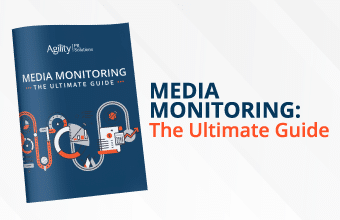There has been some debate and backlash surrounding the use of media monitoring and analysis by government agencies. But why do government departments and agencies really use services like this?
Traditionally, the purpose of governmental media monitoring and analysis is to analyze who is saying what, where, and which key messages have the most influence on public opinion. This data alone can be an integral part of any government communications plan, but there are other ways these departments can leverage media monitoring services and the data that’s generated.
Issues management
Issues-based monitoring and analysis can help government bodies pinpoint which specific issues should be prioritized according to public opinion. Who is saying what? Where? What key message or issue is repeatedly covered in media or by social media users?
This type of monitoring and analysis can help strategize future communications regarding the issue by identifying who is talking about it and what they’re saying. This allows communication departments to tailor messaging that’s both compelling and informative to the public. Using archived media data, government bodies can also study similar issues in the past and draw insights for future communications plans.
Using media monitoring and analysis, government bodies can analyze how different regions perceive and discuss various topics which can, in turn, help uncover issues that may have not been previously known to the department.
Reputation management
Government bodies can implement a media monitoring and analysis strategy to manage their reputation and how they’re perceived. Media monitoring and analysis can help identify which key influencers are talking about the department, what they’re saying, and the general reception of their message.
This information can identify which journalists and bloggers are positively aligned with government values and messaging, and who is most likely to advocate for them. Government bodies can also identify their largest critics, and allow them to address key points and opinions.
Using media monitoring for reputation management can also ensure that the media is maintaining the integrity of a message. Is the intended message getting through to the public? or is it being misinterpreted? Media monitoring allows communications plans to be altered during a campaign to ensure the messaging is as clear and concise as possible.
Lastly, media monitoring and analysis can be used to measure the impact and perception of a message and evaluate the effectiveness of communications plans and campaigns. Government bodies can use the collected information to improve publicly funded programs by analyzing both positive and negative reception to government messaging. This crucial feedback can provide the basis for important infrastructure and policy changes, such as building a new community centre, or making sure that existing public buildings are universally accessible.
Risk management
Using media monitoring and analysis for risk management also allows government departments to create strategies surrounding potential risks.
Uniquely, media monitoring and analysis can also help manage the risk associated with using specific vendors. By gathering and analyzing content and coverage surrounding suppliers, it’s possible to establish if the vendor is someone worth working with, or if their reputation could be a potential risk.
A media analyst can compile all of the data about a specific vendor and provide a snapshot of its history, important coverage, and whether or not they are seen favourably based on media data. This information is incredibly important to government bodies as it allows them to minimize the risk associated with finding and employing new contractors and vendors.
Analysis of media coverage can also help identify new and potentially devastating risks in combination with analysis of other data points. This information allows government bodies to scale potential risks based on how likely they are to become a problem: Is it an immediate threat? Could it be a threat in the near future?
Future planning
Lastly, government bodies can take all of the acquired information and aggregated data from implementing media monitoring and analysis and use it to create informed strategies and budgets for the next fiscal year.
The data provided by media monitoring can stand as a rationale for government decisions moving forward, and any new data can be used to implement more informed communications strategies. Both government agencies and citizens alike can benefit from the insights media monitoring and analysis provides.








